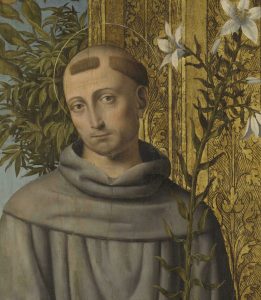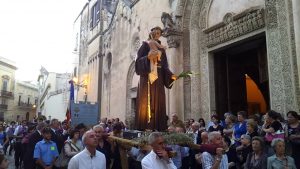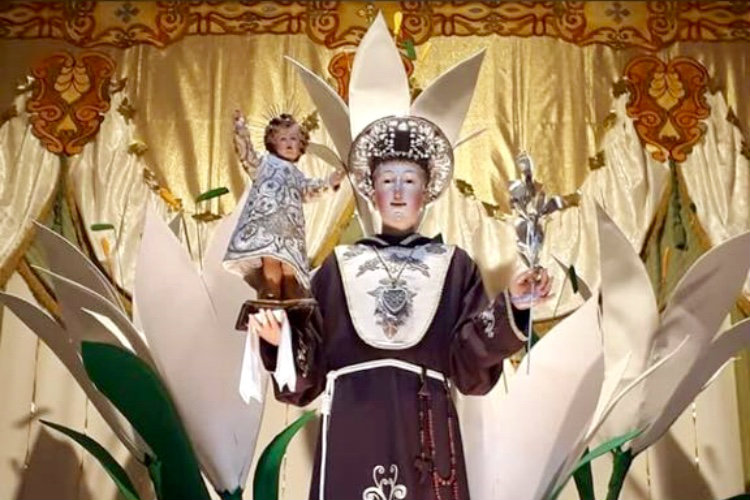"Thirteen stars form a crown Antonio is the patron saint of this city ..." It is May 31st when a Lamezia Terme, in Calabria begins the "Thirty-nine". It is one of the characteristic devotions to the Saint of Padua: the party prepares for thirteen days. The devotion to Saint Anthony originates from the popular belief that the Saint grants his devotees thirteen graces every day and from the fact that the feast occurs on the 13th of the month, the anniversary of his death on 13 June 1231. In the city there are almost everywhere you can see with the program dedicated to these days, the times of masses and solemn songs in honor of the saint that take place throughout the day so that everyone can participate. In the evening, the balconies of many buildings are illuminated by the little picture of Sant'Antonio, a wooden picture with the effigy of the saint and 13 light bulbs representing the thirteen stars.
The life of Saint Anthony

But taking a step back… who he was St. Anthony? And why in more than one city in Italy and beyond is devotion to the saint "all full of goodness" so strong - taking up popular song again?
He was born in Lisbon, with the name of Fernando Martins de Bulhões, between 1191 and 1195, which became the capital of Portugal only in 1255. After entering the order of canons regular in 1212, acquired a solid biblical and theological education, he was surprised by a an event that awakened in him the missionary ideal of St. Francis of Assisi (1189-1226): the martyrdom of the first five Franciscans in the mission to Morocco. So he decided to enter the friars minor and he also left a missionary for Morocco, with the name of Fra Antonio. A storm, however, will take him to Sicily, and from there to Assisi, where the General Chapter of the friars of San Francesco had been called. Continuing his activity as a preacher, he traveled to northern Italy and, between 1225 and 1227, to the French regions of Languedoc - so called because the language of oc was spoken there - and Provence, where he became famous for his oratory skills: he spoke in squares and markets, because the churches were not enough to contain the crowd that came to listen to him. Meanwhile, in those years the Cathar heresy spread in France, rejecting the official positions of the Church, rejecting the sacraments and exasperating the significance of the struggle between God and Satan in earthly life. The task of the preaching friars was precisely to combat the spread of heresies. Later Antonio founded in Bologna, with the authorization of Francis of Assisi, a theological school to instruct the Franciscan friars.

He lived in Padua from 1229 until his death in 1231. Of his life, which made him one of the most beloved saints, gestures of great virtue and ardor are known. He worked, especially in Padua, to pacify adverse political factions. He courageously, though unsuccessfully, asked Ezzelino da Romano, tyrant of Verona, to free his Guelph prisoners. He was canonized in 1232 by Pope Gregory IX, proclaimed patron and protector of Padua in 1256 and doctor of the Church in 1946. The center of his cult is the basilica erected in Padua, on the site of his tomb.
Miracles
Numerous miracles are attributed to Saint Anthony of Padua: among others an episode of bilocation - he was seen at the same time in Padua, where he gave a sermon, and in Lisbon, where he had gone to save his father condemned to death. Or the sermon to the fish and the miracle of the mule fasting for three days who kneels in front of the monstrance, favoring the conversion of his formerly atheist master.

He also had a reputation as a miraculous healer; moreover, he is the saint to whom he turns, hoping to find a lost object. In iconography, that is, in paintings and images, it is usually presented with a lily, a symbol of fidelity and purity of the soul and body, or with the Infant Jesus in his arms.
Sant'Antonio also had a particular fondness for children. Among the miracles he performed when he was alive, more than one concerns them. This is why the tradition of placing the little ones, from birth, under the protection of the Saint is widespread. This custom is followed by that of having children wear the Franciscan habit to thank the Saint for the protection received and make it known to others.
The cult
A little-known curiosity about the history of the cult of Saint Anthony: from 1799 to 1814, for fifteen years, he replaced the famous and celebrated San Gennaro as the patron saint of the city of Naples, because the latter was accused of being a partisan of the defeated republican democracy , of freedom, of equality and therefore of being a friend of the "Jacobins".
Numerous associations in the world were born and operate in the name of the saint, especially reviving his charitable presence. For centuries, all over the world, millions of people have shown themselves to be linked to Saint Anthony with great love and authentic devotion.
Devotees see the saint as a friend, listener and confidant. He is the interlocutor of the poor, who converses with anyone who has to share some suffering in body or spirit.






